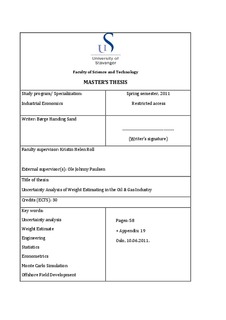| dc.contributor.author | Sand, Børge Handing | |
| dc.date.accessioned | 2014-02-06T10:03:16Z | |
| dc.date.available | 2014-02-06T10:03:16Z | |
| dc.date.issued | 2011-06 | |
| dc.identifier.uri | http://hdl.handle.net/11250/182326 | |
| dc.description | Master's thesis in Industrial economics | en_US |
| dc.description.abstract | Main objective is to analyze uncertainty with respect to WEPS (Weight Estimating and Project Screening) and Ramboll’s methods for weight estimation and how it performs. The reason for evaluation of an already implemented and well used tool is the high demand for continual improvement of precision tools and low margin of error. The intention with the thesis is to bring to attention areas of concern and suggest solutions to minimize the uncertainties. Another part is to analyze performance of WEPS and look at alternative solutions. This required research on relevant topics. Some internal literature is available in Ramboll and some information is attained through attending WEPS development meetings. The thesis is in some degree built on industry standards and theory about risk and uncertainty management. The risk picture is presented with a bow-tie diagram, which the key uncertainty issues are derived from and further evaluated. The results are uncertainty related to the following key issues: input values, model sensitivity, experience and data material. These issues are categorized in Conceptual- and Operational - uncertainty. Methods for how to minimize, eliminate or control the uncertainty are evaluated. It is found that conceptual uncertainty could be handled by training of estimating team in relevant topics for estimation. It is also found that information management could impact and minimize the related uncertainty. Operational uncertainty is normally handled by the use of weight allowances and weight budgets. This is assessed as a well functioning method for managing weight constraints for indefinable elements and unforeseen consequences. The model accuracy and uncertainty of WEPS is analyzed according to class B estimate. The results are compared with as-built data and a simpler alternative method. This alternative method is created by the author for the purpose of this thesis. The analysis is done by estimation of ten projects by each method in two separate rounds and study of the results. The result from the first round show that WEPS gives poor base estimate but it is often just one or two factors that contribute to this error. Over all the analysis shows that it is possible to achieve significant result for B estimate and points to evidence that also C and D estimate is possible. These classes have not been fully tested in this thesis. Reason for not testing these classes is mainly the needed for a professional estimator, which can secure sufficient and confident estimates for the analysis. This is not available for the analysis. The unexpected result is that the alternative method performs better both according to accuracy and uncertainty. This is probably due to restriction in time for analysis. The evaluation of WEPS show that WEPS is a highly technical, adaptive and detailed method for estimation of weight that meets the requirements for class B set by the industry standard TR1244. It gives the estimator full control and many possibilities in all aspects of the estimation process. There are aspects of conceptual - and operational - uncertainties present. Some methods for managing the total uncertainty are introduced. The final conclusion must be that the WEPS method has some areas of concern related to uncertainty and accuracy. The alternative method for estimating which is introduced show promising result. | en_US |
| dc.language.iso | eng | en_US |
| dc.publisher | University of Stavanger, Norway | en_US |
| dc.relation.ispartofseries | Masteroppgave/UIS-TN-IØRP/2011 | |
| dc.subject | usikkerhet | en_US |
| dc.subject | vekt | en_US |
| dc.subject | estimering | en_US |
| dc.subject | statistikk | en_US |
| dc.subject | økonometri | en_US |
| dc.subject | industriell økonomi | en_US |
| dc.title | Uncertainty analysis of weight estimating in the oil & gas industry | en_US |
| dc.type | Master thesis | en_US |
| dc.source.pagenumber | 77 | en_US |
